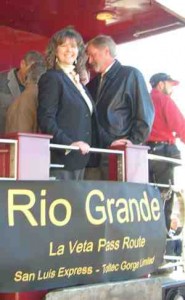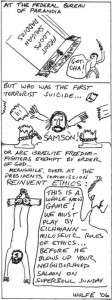Essay by John Mattingly
History – August 2006 – Colorado Central Magazine
JUST NORTH OF MOFFAT on Highway 17, on the east side of the road, stands the old Wagon Wheel Cafe, now empty, guarded by trees and weeds.
When I first came to the Valley in 1987, it was a hub of conversation, coffee, and late lunches for locals. I had just started as manager of Cotton Creek Ranch that year, hired in the middle of an ill-conceived sheep drive up to Bristol Head. An embarrassing number of ewes had escaped, partly because the drive had been conducted by cowboys on horseback instead of shepherds with dogs.
Outside the Wagon Wheel, I noted the large number of flatbed pickups with hay stems stuck in the corners and decided to stop to ask if anyone had seen stray ewes.
Inside the cafe, the floor was uneven. It felt like maybe the joists were warped or a few were missing. What light made it through the several small windows was filled with the faint smoke of frying, the clinking of spoons in coffee cups, a few shuffles and coughs.
I heard a prominent bootstraps rancher from Moffat, leading a discussion about inflated property taxes. “I’ll jump on my dozer and tear the sons of bitches down if the county don’t lower the levy. That’ll settle that in a hurry.”
“You know the difference between God and a tax assessor don’t you?”
“Got a feelin’ you’re gonna tell me.”
“God don’t think he’s a tax assessor.”
Several other ranchers were discussing the condition of the grass in various parts of the country, speculating as to when they could turn out. The price of hay was argued, but no one would commit to the exact dollar per ton until it was in the bale.
After a small silence, a man in the corner ventured a change of subject: “With Brady comin’ on, Moffat should make it to state next year in basketball.”
When I asked if anyone had seen stray ewes, silence fell over the cafe. No one knew who I was, but everyone had heard about the fiasco with the ewes. Soon, there were nods around the dining area, someone speaking into his sleeve, “Go west on Road T, can’t miss ’em.”
I heard a round of laughter resounding through the walls of the Wagon Wheel, while I stood in the parking lot wondering whether Road T was north or south.
A couple of years later, when working with the water rights of Cotton Creek Ranch, I needed to know about the historical flows of Cotton Creek, so I found Ralph Mitchell — then Moffat’s most notorious 90-year old farmer/rancher — having an early breakfast at the Wagon Wheel. He’d watched the Creek all his life and gave me a sworn statement over bacon and eggs.
The Wagon Wheel hasn’t been open for at least 15 years now. It’s been for sale, but for whatever reason hasn’t found an owner willing to open it up again. Every time I drive by I remember some small incident that took place there.
It might have been known as a greasy spoon, but it was what many new age folks call community: the local gathering place, where, before cell phones and email addresses, you could always find that certain person you needed to find, once you knew when they took their coffee.
ABANDONED BUILDINGS have always turned my eye. The fascination goes to imagining what happened behind those weathered walls in the good times, and then wondering about the hardships that must have followed, hardships so severe that the place stopped being a place and started its slow retreat back to the elements. I can’t help but appreciate that a similar fate could await my own efforts, if not all of us in the arid West.
The West is deceiving country. It’s tricked settlers for 150 years. When it rains and snows at the right times and places, but doesn’t frost, hail, or blow at the wrong times, the West can look like Iowa. Only to take on the countenance of an Arizona desert after a pair of dry years. People’s fortunes are closely tailored to the weather.
At the north end of the San Luis Valley, the towns of Mirage and Cotton Creek once had populations in the hundreds. Each had a post office, a school, buildings of commerce. Now all that remains are a few scattered stones and bug-eaten logs. It may be that the Wagon Wheel hints at an impending succession in human culture on a fragile landscape. It doesn’t take much imagination to see the Wagon Wheel slowly disappear as did Mirage and Cotton Creek. And what will be next?
John Mattingly writes from greater Moffat, where he is attempting a 12-step program to quit farming.


